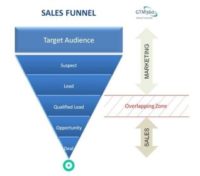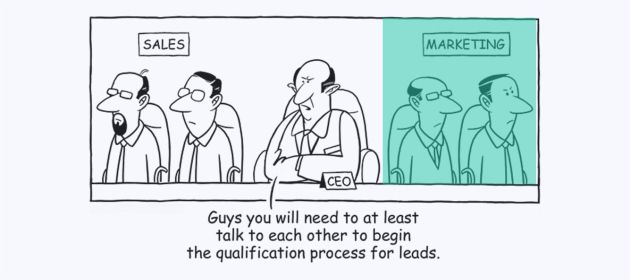When we published Increasing Sales-Marketing Alignment: Big Bang Doesn’t Work six years ago, there were 4.3 million search results for the keyword “Sales Marketing Alignment”.
Today there are 58.3 million.
Safe to say that there has been an explosion in online chatter on the topic – it works out to 54% CAGR for the mathematically inclined.
I’m guessing that much of that increase happened during the recent lockdowns caused by the coronavirus pandemic outbreak.
With field visits almost grinding to a standstill in the IT industry, both field sales and inside sales are working from home. It doesn’t take a genius to deduce that the “remote working” situation would have caused greater scope for friction between the two functions and heightened the interest among the C-Suite to drive alignment between them during the last 5-6 months.
I expect that tendency to intensify going forward*.
So I thought it’s a good time to revisit this ever-trending topic.
Why Misalignment
To recap, the following are the key areas of misalignment between sales and marketing:
From Marketing POV:
- Sales does not follow up with leads generated by us
- Sales does not use the marketing collateral developed by us, instead cobbling together half-baked content for each opportunity
- Sales rarely updates us about the status of opportunities
- Sales never shares customer feedback about our content
From Sales POV:
- Marketing wastes our time with leads that will never buy
- Marketing is drunk on the Kool-Aid of industry megatrends (read Gartner / Forrester reports) whereas our prospects are least bothered about anything beyond their company and industry
- Marketing shoots off high level ideas for generating additional business from existing customers without adapting them to individual situations
- Whenever Marketing fixes sales meetings, prospects have unrealistic expectations about our company and products.
Driving Alignment – Marketing POV
In this post, I’ll outline ways to eliminate the aforesaid areas of misalignment from Marketing POV.
Lead Quality / Followup
Despite the passage of time, we still see a lot of disconnect regarding lead quality and follow up.
In my experience, the chief cause of the disconnect -and the ensuing friction between sales and marketing – is the lack of agreement on what a lead means and inadequate clarity on roles and responsibilities towards generating and following up a lead.
Over the years, we have come across various definitions of leads at different companies, the three most common ones being:
- L1: Lead is a name and email of somebody in a prospect company in the Target Audience who has not heard of you i.e. Seller.
- L2: Lead is someone in the prospect company who has heard of you and has expressed an interest in knowing more about what you offer.
- L3: Lead is somebody in the prospect company that will place the order on you tomorrow.
Nothing right, nothing wrong, sales can define a lead whichever way it wants.
But, after it has defined a lead in a particular way, sales has to accept all leads that meet that definition. Individual sales reps shouldn’t be permitted to indiscriminately reject leads that don’t fit their personal fantasy of a lead.
Then the C-Suite should also appreciate that the effort required to generate a lead can vary from 1-100X – repeat 100X – depending on how a lead is defined. If Marketing needs to give a nudge to the C-Suite in this regard, it can use the calculus presented in our blog post entitled The Secret To Success Of Outsourcing B2B Lead Generation.
Accordingly, Sales and Marketing should first reach an agreement on the quality of lead. Then the C-Suite should be willing to fund Marketing adequately such that it can generate the required quantity of the agreed quality of leads. This is a very crucial step. Without this, the misalignment between Sales and Marketing will never go away.
When it comes to who does what with a lead, CxOs tend to brush the topic off with the offhand remark, “revenue is all that matters”. This is not wrong but it is the source of a lot of misalignment.
Imagine what would happen in a football / soccer game where the coach tells his team “I don’t care who plays as striker, midfielder or goalkeeper, all I want is goals”.

Like in a football team, everybody in a company must have their eyes on the ultimate result but, just as a football coach knows, the C-Suite should appreciate that everybody in their company is not equally qualified – or compensated – for revenues. Therefore, ambiguity in roles and responsibilities between Sales and Marketing in handling leads must be averted as far as possible.
A low hanging fruit tactic for improving clarity is to create an “overlapping zone” in the sales funnel. As shown in the graphic on the right, it lies typically between the Lead and Opportunity stages.
As I highlighted in my blog post When Does Marketing End & Sales Start?, Marketing shouldn’t just generate Qualified Leads and “throw them over the wall” to Sales. Instead, Sales Development Reps / Inside Sales Executives should work together with Field Sales Reps while a case is in the overlapping zone.
Marketing Collateral
In many IT companies, Marketing sends out new collateral to Sales by email as and when it publishes them. Sales finds them interesting but, lacking any immediate prospect to sent it to, files it away.
And, when a Sales Rep needs a specific collateral for a given customer opportunity, she’s not able to locate it.
As a result, she creates new collateral for every opportunity.
In a typical B2B technology sales cycle, there’s always a shortage of time when this happens. As a result, there’s a mad scramble, people who’re not best suited for this job create these collaterals under acute time pressure.
Not surprisingly, those collaterals don’t work.
Over time, it’s forgotten that the half-baked material was created by Sales. Marketing is inevitably made the fall guy for their poor quality and lack of effectiveness because “marketing owns content”.
Therefore, even though it’s not Marketing’s fault, it’s in Marketing’s interest to find a proactive solution for this problem.
Well said @alainbejjani : “It may not be your fault, but it is your problem.” https://t.co/PT5mfXdHWjhttps://t.co/PuOC9mW5JV
— Ketharaman Swaminathan (@s_ketharaman) August 18, 2017
A good solution is to create a central portal where marketing collaterals are published and can be searched. I’m a little amazed that I’m having to say this 2020 but the fact is that I haven’t seen such a portal in many small and midsized IT companies.
Now, a typical marketing executive is not a geek, so you can see how this could lead to an impasse. But it’s still Marketing’s job to come out of it.
Hope the following anecdote helps.
I was the Marketing Manager at an ERP company in the early 2000s. During a smoke break, I ran into a techie and heard about something called Frontpage. This popular website builder from Microsoft would now be called a “no-code platform” but the jargon didn’t exist at the time. All the same, Frontpage enabled me to build a marketing collateral portal within a week – without knowing how to write a single line of HTML code. This proved to be a game-changer towards driving sales-marketing alignment in that company.
I often cite this anecdote to illustrate the power of serendipity – and smoke breaks!
 For those who prefer BUY over MAKE, I’d recommend a Digital Asset Management software for hosting marketing collateral. Sorry for the shameless plug but our MARCOL360 platform is a cost-effective DAM solution for midsized companies. Traditionally hosted on a company’s Intranet, DAMs are increasingly being opened up to channel partners, customers and prospects – i.e. “externalized” – in what could be seen as a step taken by companies towards digital transformation of their sales and marketing operations for the post-Coronavirus world.
For those who prefer BUY over MAKE, I’d recommend a Digital Asset Management software for hosting marketing collateral. Sorry for the shameless plug but our MARCOL360 platform is a cost-effective DAM solution for midsized companies. Traditionally hosted on a company’s Intranet, DAMs are increasingly being opened up to channel partners, customers and prospects – i.e. “externalized” – in what could be seen as a step taken by companies towards digital transformation of their sales and marketing operations for the post-Coronavirus world.
As an aside, “externalizing of marketing collateral” is one of those “best practices” we’ve been talking about for years and, boom, it happens in a matter of months, courtesy a Black Swan event.
Ditto US Ecommerce Penetration (% of Retail Sales):
5.6% to 16% in 10 years. 16% to 27% in 8 weeks. pic.twitter.com/unpQb7tXdV— Ketharaman Swaminathan (@s_ketharaman) May 17, 2020
Opportunity Status
With the growing use of CRM systems to log leads and track their progress through the funnel, this problem can be solved easily: Simply give CRM access to Marketing so that they can keep themselves updated on the status of every opportunity.
Content Feedback
Marketing takes a lot of effort to produce content. It’s only natural for content marketing executives to crave for customer feedback on the content developed by him or her.
But it’s hard for Sales to fulfill this expectation because, while content is an important ingredient in B2B sales, it’s not the only one. Prospects may very well weigh in on vendor content within their internal purchase committee meetings but they’re unlikely to share their feedback on each and every individual piece of content with sales reps.
Ergo, content marketing executives should stop seeking customer feedback for their content, and instead be – ahem – content with feedback from Sales. DAM platforms like MARCOL360 support rating of each piece of content, which will handily serve as feedback from Sales reps.
Interestingly, one of our customers is planning to extend access of its MARCOL360 to the outside world in the post-pandemic era. When that happens, the company’s content marketing executives will be able to fulfill their wish to receive customer feedback on each and every piece of content developed by them!
With some integration between the DAM and CRM software, it should be possible to link opportunity stage with specific marketing collateral. This will help Marketing gain visibility into which type of content generated highest conversion from one stage of the sales funnel to the other, drove maximum closures, and other content marketing metrics.
We’ve covered many ways to boost sales-marketing alignment from Marketing POV. Implementing them is fraught with challenges but they provide a good starting point to eliminate this long-standing problem.
In a follow-on post, we’ll pick up the thread from Sales POV. Watch this space!
UPDATE DATED 5 APRIL 2022:
*: It has. The number of search results for the keyword “Sales Marketing Alignment” now is 80.2 million, up 50% from 53.3 million, which was the corresponding figure when the original post was published.
